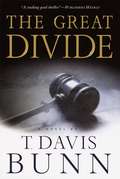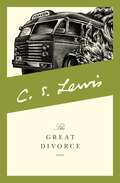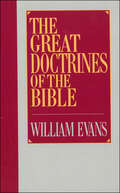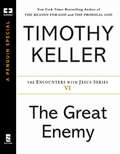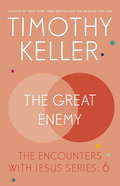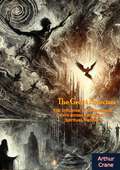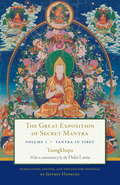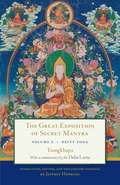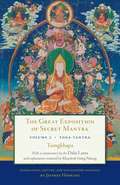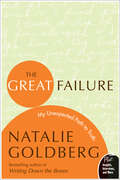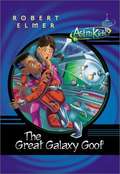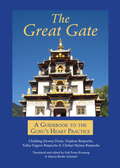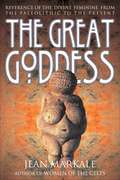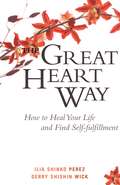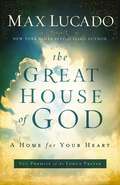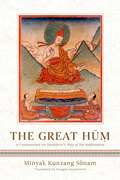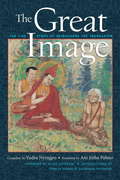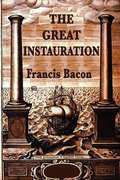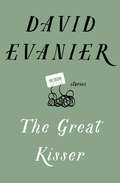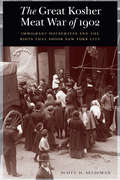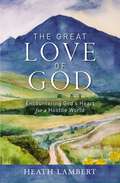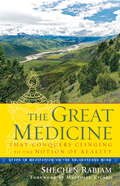- Table View
- List View
The Great Divide
by T. Davis BunnWhen attorney Marcus Glenwood resigns from a prestigious corporate law firm to retreat to a small town in North Carolina and rebuild his life after a devastating personal tragedy, he suddenly finds himself in the biggest and most emotionally difficult case of his career.Fragile and spiritually wounded, Glenwood is introduced to Alma and Austin Hall, whose daughter Gloria has disappeared in China while investigating the slave-like practices of New Horizons, the world's largest manufacturer of sports shoes and athletic gear. Persuaded by Alma's pleading, and their obvious distress, Marcus accepts the case.No one, including Marcus himself, can believe how quickly his investigation untangles a web of deceit that stretches from Washington , D.C., to Europe and Asia and back to his own North Carolina backyard. With the power to obstruct, manipulate, intimidate, injure, and eliminate, the giant multinational sports company New Horizons has never lost a case. But they underestimate Marcus Glenwood.Step by cautious step Glenwood moves forward to uncover the horrifying truth about New Horizons, Gloria Hall, and ultimately himself.From the Trade Paperback edition.
The Great Divorce (C. S. Lewis Signature Classic Ser.)
by C. S. LewisC. S. Lewis takes us on a profound journey through both heaven and hell in this engaging allegorical tale. Using his extraordinary descriptive powers, Lewis introduces us to supernatural beings who will change the way we think about good and evil.
The Great Doctrines of the Bible
by William EvansA well-organized examination of ten major doctrines, including 80 subjects by topical listing. Designed to supplement personal Bible study.
The Great Doctrines of the Bible
by William EvansA well-organized examination of ten major doctrines, including 80 subjects by topical listing. Designed to supplement personal Bible study.
The Great Enemy
by Timothy KellerThe Gospels are full of encounters that made a profound impact on those who spoke with Jesus Christ. In his Encounters with Jesusseries, Timothy Keller, pastor of New York's Redeemer Presbyterian Church and New York Times-bestselling author of The Reason for God, shows how those encounters can still have a deep effect on us today. The baptism of Jesus and his temptation in the desert are two well-known experiences of Christ, yet it is often forgotten that they go together. In The Great Enemy, Keller explores the contrast between Jesus' encounters with God and Satan. He explains why evil is deeper, more nuanced, and more complex than we think, and how we can confront and weaken its destructive force in our lives. This and the other nine in the series make up the complete Encounters With Jesus: Unexpected Answers to Life's Biggest Questions.
The Great Enemy: The Encounters With Jesus Series: 6
by Timothy KellerThe Gospels are full of encounters that made a profound impact on those who spoke with Jesus Christ. In his Encounters with Jesusseries, Timothy Keller, pastor of New York's Redeemer Presbyterian Church and New York Times-bestselling author of The Reason for God, shows how those encounters can still have a deep effect on us today. The baptism of Jesus and his temptation in the desert are two well-known experiences of Christ, yet it is often forgotten that they go together. In The Great Enemy, Keller explores the contrast between Jesus' encounters with God and Satan. He explains why evil is deeper, more nuanced, and more complex than we think, and how we can confront and weaken its destructive force in our lives.This and the other nine in the series make up the complete Encounters With Jesus: Unexpected Answers to Life's Biggest Questions.
The Great Exorcism: The Influence of Demons and Devils across Centuries of Spiritual Tradition
by Arthur CraneThe Great Exorcism by Arthur Crane is an intriguing exploration of the supernatural, blending fiction, spirituality, and psychological inquiry. The narrative delves into themes of possession, inner conflict, and the eternal struggle between good and evil, creating a suspenseful and thought-provoking story centered around the process of exorcism. Crane’s work not only offers a thrilling account of a battle against dark forces but also raises questions about faith, belief, and the human psyche.At its core, The Great Exorcism follows the journey of individuals confronted with mysterious and malevolent forces beyond their control. The exorcism becomes a dramatic focal point in which physical and spiritual realms collide, placing both the possessed and the exorcists in a battle that challenges their courage, conviction, and humanity. Crane presents exorcism as not merely a ritual but a symbolic confrontation with personal fears and unresolved guilt, deepening the emotional and philosophical dimensions of the story.Through vivid descriptions and intense scenes, the narrative explores the delicate interplay between rational skepticism and spiritual faith. Characters grapple with doubts and conflicts that reflect larger societal tensions between science and religion. Crane’s storytelling skillfully weaves these elements together, creating a narrative that is as much about internal transformation as it is about supernatural confrontation.The Great Exorcism will appeal to readers who enjoy stories about the metaphysical and psychological aspects of human experience. With its blend of suspense, reflection, and spiritual exploration, the book offers more than just a dramatic tale—it invites readers to contemplate the nature of good and evil, redemption, and the enduring power of belief. Crane’s work remains a compelling read for those drawn to stories that bridge the supernatural and the human condition.
The Great Exposition of Secret Mantra, Volume 1: Tantra in Tibet (Revised Edition)
by Jeffrey Hopkins The Dalai Lama TsongkhapaTantra in Tibet is the first volume in The Great Exposition of Secret Mantra series in which the Dalai Lama offers illuminating commentary on Tsongkhapa’s seminal text on Buddhist tantra. It is followed by Volume II: Deity Yoga and Volume III: Yoga Tantra.This revised work describes the differences between the Mahayana and Hinayana streams in the sutra tradition, and between the sutra tradition and that of tantra generally. It includes highly practical and compassionate explanations from H.H. the Dalai Lama on tantra for spiritual development; the first part of the classic Great Exposition of Secret Mantra text; and a supplement by Jeffrey Hopkins on the meaning of emptiness, transformation, and the purpose of the four classes of tantra.
The Great Exposition of Secret Mantra, Volume 2: Deity Yoga
by Dalai Lama Jeffrey Hopkins TsongkhapaHis Holiness the Dalai Lama illuminates the highly practical and compassionate use of Tantra for spiritual development in this important classic work.Deity Yoga is the second volume in The Great Exposition of Secret Mantra series in which the Dalai Lama offers illuminating commentary on Tsongkhapa’s seminal text on Buddhist tantra. It is preceded by Volume 1: Tantra in Tibet and followed by Volume 3: Yoga Tantra.This revised work describes the profound process of meditation in Action (kriyā) and Performance (caryā) Tantras. Invaluable for anyone who is practicing or is interested in Buddhist tantra, this volume includes a lucid exposition of the meditative techniques of deity yoga from H.H. the Dalai Lama; the second and third chapters of the classic Great Exposition of Secret Mantra text; and a supplement by Jeffrey Hopkins outlining the structure of Action Tantra practices as well as the need for the development of special yogic powers.
The Great Exposition of Secret Mantra, Volume 3: Yoga Tantra
by Dalai Lama Jeffrey Hopkins TsongkhapaHis Holiness the Dalai Lama illuminates the highly practical and compassionate use of Tantra for spiritual development in this important classic work.Yoga Tantra is the third volume in The Great Exposition of Secret Mantra series in which the Dalai Lama offers illuminating commentary on Tsongkhapa’s seminal text on Buddhist tantra. It is preceded by Volume I: Tantra in Tibet and Volume II: Deity Yoga.This work opens with His Holiness the Dalai Lama presenting the key features of Yoga Tantra then continues with Tsongkhapa’s section of the main text focusing on this class of tantra. This is followed by an overview of the central practices of the five manifest enlightenments and the four seals written by Khaydrub Je (Khaydrub Geleg Palsang), one of Tsongkhapa’s main students and the first in the line of Panchen Lamas. Jeffrey Hopkins concludes the volume with an outline of the steps of Yoga Tantra practice, which is drawn from the Dalai Lama’s, Tsongkhapa’s, and Khaydrub Je’s explanations.
The Great Failure: My Unexpected Path to Truth
by Natalie GoldbergOne of America's favorite teachers, Natalie Goldberg has inspired millions to write as a way to develop an intimate relationship with their minds and a greater understanding of the world in which they live. Now, through this honest and wry exploration of her own life, Goldberg puts her teachings to work.
The Great Galaxy Goof (AstroKids #1)
by Robert ElmerMeet the Astrokids--Buzz, Miko, Mir, DeeBee, and Tag--five friends learning biblical truth through out-of-this-world adventures aboard space station CLEO-7. "You've never been to space? Oh yeah, of course not. You're still in the 21(st) century. Well, it's AWESOME! I was pumped when my family got to move here to CLEO-7. "That is, until this mystery kid popped up on my wrist interface. I didn't help things when I accidentally took his new zipsuit for a test flight (whoops!)... and then there was the whole space-shuttle mix-up ... What a mess! Thank goodness for my new friends, the AstroKids!"
The Great Gate
by Tulku Urgyen Rinpoche Chokyi Nyima Rinpoche Chokling Dewey DorjeThe Great Gate, A Guidebook to the Guru's Heart Practice, is a compilation of instructions on the preliminary practices by the great masters, Chokling Dewey Dorje, Dudjom Rinpoche, Tulku Urgyen Rinpoche & Chökyi Nyima Rinpoche. Clear direct and personal, these teachings lucidly explain the application of key practices in the Vajrayana path, the pinnacle of which is the Great Perfection, the deepest and most undeviating way to attain enlightenment. The methods of the masters presented in this book focus on the simple approach of a meditator that is saturated with direct, pithy instructions. This is a tradition of plainly and simply stating things as they are, allowing the student to gain personal experience by challenging their intellect and guiding them towards realization.
The Great Gate: A Guidebook to the Guru's Heart Practice, Dispeller of All Obstacles
by Rinpoche Dudjom Kyabje Rinpoche Urgyen Tulku Dorje Dewey ChoklingVajrayana Buddhism differs from other branches of Buddhism in providing an accelerated path to enlightenment based on Dzogchen principles. The word dzogchen, translated variously as Great Perfection and Great Completeness, conveys the idea that our nature as intrinsic awareness has many qualities that make it "perfect": indestructibility, incorruptible purity, non-discriminating openness, flawless clarity, profound simplicity, all-pervading presence, and attitude of equality toward all beings. The path to connecting to these qualities was once secretly held and privately transmitted; The Great Gate: A Guidebook to the Guru's Heart Practice makes the Vajrayana path and techniques available to contemporary seekers. Drawing on the work of four renowned Tibetan masters, The Great Gate compiles concise instructions on Dzogchen's foundational practices, which comprise a powerful method for turning the mind toward the Dharma and opening to the Dzogchen perspective. This revised edition features a new translation and an extensive commentary by Chökyi Nyima Rinpoche.From the Trade Paperback edition.
The Great Goddess: Reverence of the Divine Feminine from the Paleolithic to the Present
by Jean Markale• A study of the primordial figure of the Great Goddess and her continued worship through time as shown by the myths, shrines, and sanctuaries around the world that honor this powerful symbol of creation. • A noted historian on pre-Christian societies provides an extensive worldwide listing of sites and sanctuaries associated with goddess worship. • Explores goddess worship in cultures around the world, including Native American, Egyptian, Indian, and Oriental civilizations. • Demonstrates that although her worship has sometimes been forced underground it has never disappeared. In ancient Babylon she was Anat, in Egypt, Isis and Hathor, Dana in Celtic Ireland, Rhea and Demeter in Greece, and in India, Anapurna the Provider. She is the Great Goddess, the Goddess of Beginnings, the symbol of Earth and the giver of life, the Vast Mother, who represents all the powers and mysteries of creation for early humanity. Shifting her solar association onto masculine deities and blackening those of her symbols that, like the serpent, could not be assimilated, patriarchal societies forced the preeminent power of the feminine into an obscure and subservient position. Yet, as shown by noted scholar Jean Markale, the Goddess did not simply disappear when her position was usurped, and the power she represents has been the source of continuous religious devotion from ancient times through the Middle Ages up to the present day. In looking at the plethora of myths, sites, and sanctuaries devoted to this powerful figure, The Great Goddess provides abundant evidence of the extraordinary permanence of her worship--even at the heart of those religions that tried to destroy her.
The Great Heart Way
by Gerry Shishin Wick Ilia Shinko PerezSelf-compassion. Positive social relations. An enduring sense of freedom and peace. They're essential parts of our everyday lives, or should be. But each of us struggles with difficult emotions and mental blockages: we might lash out when we should know better, or regress in negatively familiar situations, or struggle with our confidence. These types of problematic reactions occur--and recur--when we're unkind to and negligent of our inner selves. The Great Heart Way offers us all a way to heal inner wounds and transform our difficult emotions. Anyone can try it, and everyone should. Using clear language and personal anecdotes, The Great Heart Way shows how to follow the Great Heart Method, an efficacious program for healing and self-fulfillment. The Method is easily incorporated into busy schedules (it can take less than 30 minutes per day), and is accessible to all, regardless of spiritual background. The Great Heart Way gives readers the tools to safely work through uncovered emotional pain and establish a healthier, happier and well-balanced way of thinking.
The Great House of God
by Max LucadoGod's greatest desire is to be your dwelling place. The home for your heart.He doesn't want to be merely a weekend getaway. He has no interest in being a Sunday bungalow or even a summer cottage. He wants to be your mailing address, your point of reference, your home...always. He wants you to live in the Great House of God.Using the Lord's Prayer as a floor plan, bestselling author Max Lucado takes you on a tour of the home God intended for you. Warm your heart by the fire in the living room. Nourish your spirit in the kitchen. Seek fellowship in the family room. Step into the hallway and find forgiveness. It's the perfect home for you. After all, it was created with you in mind. There's only one home built just for your heart. No house more complete, no structure more solid.The roof never leaks. The walls never crack. The foundation never trembles. In God's house, you're home. So come into the house built just for you. Your father is waiting.
The Great Hum: A Commentary on Shantideva's Way of the Bodhisattva
by Minyak Kunzang SönamDive into an ocean of Buddhist wisdom with this masterful immersion in Shantideva&’s well-known guide to the boundless spirit of the bodhisattva.Shantideva&’s Way of the Bodhisattva (Bodhicaryavatara) is without a doubt one of the greatest masterpieces of Indian Buddhism and the single most influential text on Mahayana ethical theory. Since it was composed in the eighth century, it has continuously animated the living tradition—especially in Tibet, but now in the West as well—as more translations have become available. Its poetic evocations of the spirit of awakening allow readers to enter the mind of the bodhisattva. Nineteenth-century master Minyak Kunzang Sonam composed what came to be the most extensive commentary in any language on Shantideva's masterpiece. This commentary came to be known as the Great Hum because it fills the entirety of the third or hum volume of the author&’s collected works. Citing hundreds of sutras, he shows how Shantideva&’s verses are beautifully integrated within, and express, the Buddhist textual universe. In particular he ties Shantideva&’s verses with the Anthology of Training, the thematic collection of scriptural citations also compiled by Shantideva, creating a detailed tapestry of Mahayana thought and practice. Kunzang Sonam&’s commentary on the philosophically rich ninth &“Wisdom&” chapter was published previously as The Profound Reality of Interdependence, and this volume presents his commentary on the first eight chapters, detailing the generation of the spirit of awakening, the cultivation of positive qualities, and the practice of meditation. Embedded in the commentary is a fresh translation of Shantideva&’s verses, making this an unparalleled guide to appreciating their layers of meaning and applying them in one&’s practice and life.
The Great Image: The Life Story of Vairochana the Translator
by Dilgo Khyentse Ani Jinba PalmoThis book is the autobiography of the great scholar and translator Vairochana, as told to a group of his students near the end of his life in the eighth century. Responsible for bringing seminal Buddhist teachings to Tibet from India, his deep understanding of the Dharma was what enabled him to translate the essence of enlightened mind, conveyed in the Sanskrit texts, with great accuracy.
The Great Instauration
by Francis BaconFrancis Bacon is considered the father of modern science. He proposed, at his time, a great reformation of all process of knowledge for the advancement of learning divine and human. He called it Instauratio Magna (The Great Instauration). Bacon planned his Great Instauration in imitation of the Divine Work-- the Work of the Six Days of Creation, as defined in the Bible, leading to the Seventh Day of Rest or Sabbath in which Adam's dominion over creation would be restored, thus dividing the great reformation in six parts: 1. Partitions of the Sciences 2. New Method 3. Natural History 4. Ladder of the Intellect 5. Anticipations of the 2nd Philosophy 6. The Second Philosophy or Active Science.
The Great Kisser: Stories
by David EvanierA profoundly funny—and comically profound—story collection from one of the most original voices in contemporary American fictionWhen his dying psychiatrist gives him the tapes to thirty years&’ worth of therapy sessions, what else can Michael Goldberg do but listen? It is the story of his life, after all—never mind the fact that it&’s narrated by a younger version of himself who has no idea what&’s going to happen next.Besides, as a man of letters best known for &“My Mother Is Not Living,&” the story that earned him a reputation as &“the Jewish writer who hated his mother more than any other Jewish writer,&” Michael has never been especially concerned with the niceties of literary convention. What he really wants, what he&’s been looking for from New York to Hollywood and back again—from doomed high school romances to a late marriage begun in sin and overshadowed by tragedy, from boyhood days playing stickball in the streets of Queens to middle-aged afternoons behind a desk at the activist organization Jewish Punchers, sorting masses of data into one of two files: &“Good for the Jews&” or &“Bad for the Jews&”—are answers. To life&’s great mysteries, sure, but mainly to the one question that always seems to be waiting for him, wherever he goes: How did I end up here?What Michael discovers in his therapist&’s tapes, and what David Evanier so masterfully portrays in this hilarious and heartbreaking collection, is a life that is no less inevitable for being unplanned, and no less extraordinary for being average.
The Great Kisser: Stories
by David EvanierA profoundly funny—and comically profound—story collection from one of the most original voices in contemporary American fictionWhen his dying psychiatrist gives him the tapes to thirty years&’ worth of therapy sessions, what else can Michael Goldberg do but listen? It is the story of his life, after all—never mind the fact that it&’s narrated by a younger version of himself who has no idea what&’s going to happen next.Besides, as a man of letters best known for &“My Mother Is Not Living,&” the story that earned him a reputation as &“the Jewish writer who hated his mother more than any other Jewish writer,&” Michael has never been especially concerned with the niceties of literary convention. What he really wants, what he&’s been looking for from New York to Hollywood and back again—from doomed high school romances to a late marriage begun in sin and overshadowed by tragedy, from boyhood days playing stickball in the streets of Queens to middle-aged afternoons behind a desk at the activist organization Jewish Punchers, sorting masses of data into one of two files: &“Good for the Jews&” or &“Bad for the Jews&”—are answers. To life&’s great mysteries, sure, but mainly to the one question that always seems to be waiting for him, wherever he goes: How did I end up here?What Michael discovers in his therapist&’s tapes, and what David Evanier so masterfully portrays in this hilarious and heartbreaking collection, is a life that is no less inevitable for being unplanned, and no less extraordinary for being average.
The Great Kosher Meat War of 1902: Immigrant Housewives and the Riots That Shook New York City
by Scott D. Seligman2020 American Book Fest Best Book Awards Finalist in the U.S. History category In the wee hours of May 15, 1902, three thousand Jewish women quietly took up positions on the streets of Manhattan&’s Lower East Side. Convinced by the latest jump in the price of kosher meat that they were being gouged, they assembled in squads of five, intent on shutting down every kosher butcher shop in New York&’s Jewish quarter. What was conceived as a nonviolent effort did not remain so for long. Customers who crossed the picket lines were heckled and assaulted, their parcels of meat hurled into the gutters. Butchers who remained open were attacked, their windows smashed, stocks ruined, equipment destroyed. Brutal blows from police nightsticks sent women to local hospitals and to court. But soon Jewish housewives throughout the area took to the streets in solidarity, while the butchers either shut their doors or had them shut for them. The newspapers called it a modern Jewish Boston Tea Party.The Great Kosher Meat War of 1902 tells the twin stories of mostly uneducated female immigrants who discovered their collective consumer power and of the Beef Trust, the midwestern cartel that conspired to keep meat prices high despite efforts by the U.S. government to curtail its nefarious practices. With few resources and little experience but a great deal of steely determination, this group of women organized themselves into a potent fighting force and, in their first foray into the political arena in their adopted country, successfully challenged powerful vested corporate interests and set a pattern for future generations to follow.
The Great Love of God: Encountering God’s Heart for a Hostile World
by Heath LambertIn this grave hour, we long to experience the embrace of infinite love from our Father in heaven. The importance of this great need is owing to an avalanche of problems that are now confronting us. We are hateful, lonely, hurting, scared, and confused. The cruelty in our culture has reached a state of emergency. Our generation has experienced the painful revelations of widespread abuse in leadership. At every turn we have come up short. No matter what we do the trouble persists and the fear remains. More connected than ever, but more divided, we cannot help but see a longing in ourselves and our neighbors for relationship, shared truth, and clarity of purpose.In the face of animosity, failure, isolation, and betrayal is a love that speaks to our greatest longings and heaviest needs, but have we taken God's love for granted?Now more than ever, and more than anything, people need to find their way into the compassionate embrace of their Father in heaven. The Great Love of God provides an accessible, passionate exploration of how the divine love casts out fear, provides ultimate hope, and never fails.
The Great Medicine That Conquers Clinging to the Notion of Reality: Steps in Meditation on the Enlightened Mind
by Matthieu Ricard Shechen RabjamIn these inspiring teachings on how to open the heart, a contemporary Tibetan Buddhist master shows us how to change our self-centered attitude and develop concern for the well-being of others. He teaches that when we acknowledge our own wish for happiness, we realize that all beings wish for the same. With a broader perspective, we can develop the strength to extend gratitude and kindness first to those we love, and eventually to everyone.In his warm and informal style, Rabjam offers accessible Buddhist teachings that will appeal to anyone who would like to find more meaning in life. Based on classical Tibetan teachings, his commentary is fresh, humorous, and sharply insightful. Here is a modern Tibetan teacher who appreciates the challenges of living in today's world. The Great Medicine will help contemporary readers draw on ancient teachings to find their way to wisdom, freedom, and joy amid the struggles of real life.For more information about the author, Shechen Rabjam, visit his website at www.shechen.org.
